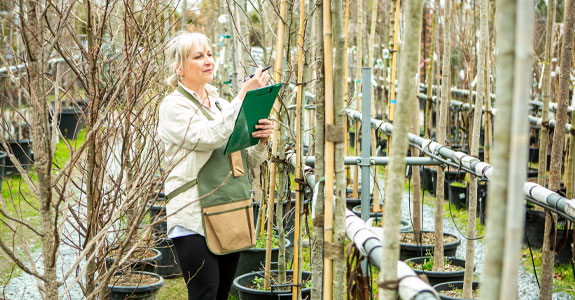Nursery insurance guide: What coverage does your business need?

Running a plant nursery involves more than growing healthy plants—it also means managing the risks that come with your day-to-day operations. Building a nursery insurance policy tailored to your operation can help protect your team, your customers, and your bottom line.
This guide highlights common risks in the nursery industry and coverage options designed to help you stay focused on what matters—cultivating vibrant ornamentals, shrubs, and trees.
The role of insurance in helping protect plant nurseries
To determine coverages that make sense for your nursery, you first need to identify the unique risk factors your business faces. Common nursery-related risks include:
Crop losses
Your container-grown plants, trees, and vulnerable stock could be put in jeopardy with damage due to equipment breakdown or severe weather. Business personal property insurance can help protect you against losses resulting from a covered event.
Equipment breakdowns
Essential tools such as grow lights, heating mats, or irrigation systems can break down, disrupting your workflow. Equipment breakdown coverage can help reduce repair or replacement costs and get you back to production sooner.
Workplace injuries
Hazards such as cluttered walkways, slippery surfaces, or poorly maintained parking lots and sidewalks can lead to costly injuries. Your insurance provider can work with you to help identify possible problem areas or create a safety plan for your business.
Theft
Equipment and cash theft—whether by external thieves or dishonest employees—is a common source of losses at nurseries. You might think you’ve secured your equipment, but thieves are resourceful. If they do manage to steal something, insurance can help you cover the replacement cost.
Storm damage
You’re in the type of business that’s susceptible to damage due to hail, lightning, high winds, and tornadoes. Depending on where you’re located, there may also be hurricanes and snowstorms. Significant storm damage repairs can be expensive and delay how quickly you can get your business up and running again.
What type of insurance do I need for my plant nursery?
Broadly speaking, the types of business insurance coverage you’ll purchase for your nursery can be divided into three categories:
Property insurance helps protect your buildings, tools, and inventory.
Commercial auto insurance covers business-related vehicle use.
Liability insurance helps protect your business from legal and injury-related claims.
Let’s take a closer look each of these three areas.
Commercial property insurance
You can customize your commercial property insurance based on specific risk exposures you face—whether it’s from fire, storm damage, theft, or equipment breakdowns. If a storm knocks out a ceiling panel and causes water damage and inventory loss, your property insurance can help cover the damage to your structure.
Commercial auto insurance
Along with growing your inventory, you likely also need to transport it. Nursery transport vehicles can be heavy and difficult to drive, heightening accident risks. Commercial auto insurance can help cover you if there’s an auto accident when you or your employees drive for business purposes.
General liability insurance
A general liability insurance policy helps cover losses to non-employees caused by your services, business operations, or employees. For example, let’s say a customer is hurt after tripping over a hose while checking out stock on your property. You could be held liable for their medical expenses and any compensation.
Umbrella liability insurance
While most claims are covered by your general liability insurance policy, certain incidents or lawsuits may be so severe they deplete the limits of your main coverage. Umbrella liability coverage provides an extra layer of coverage that can help protect your business in the event of a catastrophic liability loss or a large judgment against you or your company.
Workers’ compensation
Depending on the number of employees you have, workers’ compensation insurance may be required in your state. This insurance can help protect you against liability from a work-related accident, including injuries, illnesses, disabilities, and death. It also helps your employees with medical expenses, wage replacement, and other covered benefits after illness or injury.
How to choose the best plant nursery insurance for your business
Work with an insurance provider that understands the horticultural industry. Look for carriers that offer specialized coverages, risk management services, and experience in handling nursery-specific claims.
Hortica®, a brand of the Sentry Insurance Group, has supported horticultural businesses for more than 135 years, including greenhouse growers, garden centers. florists, and landscapers. Our team understands the challenges nursery owners like you face. We’ll work with you to customize coverage that fits your operation.
If you have any questions about insuring your plant nursery business or would like to review your current policy, contact us today or request a quote.
Related links:
Addressing daily hazards through regular training empowers your employees to work confidently and helps reduce accidents. A workplace culture that values safety helps ensure your team and your nursery business thrive.
A well-trained driver fleet is key to helping reduce accidents and creating a culture of safety. This guide explores how to implement best practices for new-hire driver safety training.
Your nursery business is ever-changing. Does your insurance policy reflect these changes? Here are some factors that could necessitate policy updates to help ensure you’re properly covered.
The information in this article is for informational or entertainment purposes only. View our disclaimer by going to terms and conditions and clicking on Learning Center disclaimer in the table of contents.